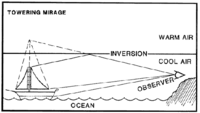Superior mirage
 The towering mirage. (Source: NSIDC)
The towering mirage. (Source: NSIDC) A superior mirage occurs when an image of an object appears above the actual object, due to the refraction or bending of light waves from the object down toward the eyes of the observer. Downward refraction occurs because air closer to the ground is colder, and therefore more dense, than air higher up.
Superior mirages can take the form of looming, towering, and inversion, depending on the particular density structure of the air column.
In looming, distant objects appear to float above the horizon, and objects that are below the horizon may come in to view. In towering, rays from the upper portion of an object are bent more than those from the lower portion. This results in the object appearing to be stretched as well as elevated.
In a superior mirage with an inverted image, the gradient in atmospheric density is so sharp that rays from the lower portion of an object are bent considerably more than rays from the upper portion of an object, causing a mirage of the object to appear inverted above the object. The object appears as it normally would at the same time, because some light continues to travel to the eye directly from the object.
Fata Morgana
The fata morgana is a complex mirage in which distant objects are distorted as well as elongated vertically. For example, a relatively flat shoreline may appear to have tall cliffs, columns, and pedestals. The phenomenon occurs under much the same meteorological conditions as the superior mirage with inversion, and contains features of both towering and inversion.
How mirages have altered the course of arctic exploration
 The superior mirage. (Source: NSIDC)
The superior mirage. (Source: NSIDC) Mirages have played a part in the history of Arctic exploration. Here are two notable examples.
In 1818, British explorer John Ross entered Lancaster Sound while seeking the Northwest Passage. He saw mountains blocking the sound, and decided to sail no further. Ross named the range the Croker Mountains, after the First Secretary of the Admiralty. But his officers never saw the mountains that Ross observed, and the Croker Mountains may have been a superior mirage. This mistaken impression was unfortunate for the expedition, because Lancaster Sound is indeed a route to the Northwest Passage, and Parliament was offering £20,000 at the time for a successful traverse of the passage. William Edward Parry, who had been with Ross in 1818, disproved the existence of the Croker Mountains by sailing west through Lancaster Sound in 1819.
In 1906, American explorer Robert E. Peary viewed a vast land northwest of Ellesmere Island from the shore of Axel Heiberg Island while on one of his eight polar expeditions. He named the land Crocker Land after his patron George Crocker. American explorer Donald MacMillan set out to find and explore Crocker Land in the MacMillan Crocker Land Expedition of 1913 to 1917. After reaching the coast, MacMillan and his men traveled laboriously over the frozen ocean toward what appeared to be the snow-capped peaks, hills, and valleys of Crocker Land. But the landscape ahead seemed to change its form and extent over time, and MacMillan realized that he and the members of his expedition were seeing, as Peary had seen, a superior mirage.
| Disclaimer: This article is taken wholly from, or contains information that was originally published by, the National Snow and Ice Data Center. Topic editors and authors for the Encyclopedia of Earth may have edited its content or added new information. The use of information from the National Snow and Ice Data Center should not be construed as support for or endorsement by that organization for any new information added by EoE personnel, or for any editing of the original content. |